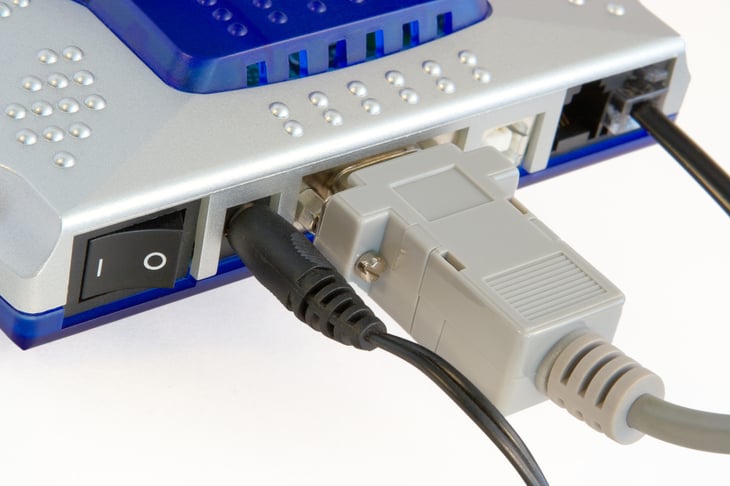
Editor's Note: This story originally appeared on The Penny Hoarder.
It feels like the cost of internet service just keeps going up.
The average American pays about $61 a month for internet service, but that figure can be much higher depending on where you live and your connection speed.
Internet and cable TV companies are notorious for offering generous introductory promotions only to jack up your bill with hidden fees and other costs over time.
The advocacy arm of Consumer Reports has even launched an initiative called Fight for Fair Internet that collected and analyzed more than 22,000 consumer broadband internet bills to see how much people are really paying — because the big internet companies don’t tell us.
Trying to save money? Here are six tips to help lower your internet bill.
1. Use Federal Government Subsidies

The Affordable Connectivity Program (ACP) provides a $30 discount on home internet service to those who qualify.
If your family is enrolled in certain federal assistance programs — or you meet income criteria — you might qualify for subsidized, low-cost internet.
You could qualify for a ACP voucher if anyone in your household is enrolled in:
- Medicaid
- Free and Reduced-Price School Lunch Program or School Breakfast Program
- Federal Pell Grant (received in the current award year)
- Supplemental Nutrition Assistance Program (SNAP)
- Lifeline
- Special Supplemental Nutrition Program for Women, Infants, and Children (WIC)
- Supplemental Security Income (SSI)
- Federal Public Housing Assistance (FPHA)
- Veterans Pension and Survivors Benefit
- Certain tribal assistance programs
You can also qualify for the program if your income is 200% of the 2023 Federal Poverty Guidelines ($39,940 for a family of two).
This can be beneficial for retirees who may have low incomes because they’re no longer working, but who don’t qualify for any of the federal assistance programs listed above.
You can fill out this application on GetInternet.gov to see if you qualify for $30 off your internet bill through the Affordable Connectivity Program.
You can use the ACP benefit with any tier of broadband service offered by an internet service provider (ISP).
Low-Income Internet Plans

Want to save even more? Ask your ISP about their low-income plans.
Most major internet providers have a low-priced plan they offer specifically to people enrolled in certain assistance programs.
Many of these plans had low download speeds in the past, but since the ACP rolled out in 2022, several companies have added a faster tier for $30.
That means if you pair the ACP voucher with a participating low-income plan, you could pay $0 a month for high-speed internet.
Here are some examples …
Access from AT&T
Price: $30
Download speed: Up to 100 mbps
Qualifying programs: SNAP or at least 200% of federal poverty level
SEE DETAILS
Cox Connect2Compete
Price: $9.95
Download speed: Up to 100 mbps download speeds
Qualifying programs: Families on assistance with K-12 children
SEE DETAILS
Internet Essentials (Comcast Xfinity)
Price: $9.95/$29.95
Download speed: Up to 25/100 mbps upload
Qualifying programs: School lunch, HUD, Medicaid, SNAP, SSI, more
SEE DETAILS
Mediacom Connect2Compete
Price: $9.95/$30
Download speed: Up to 25/100 Mbps upload
Qualifying programs: At least one K-12 child eligible for school lunch
SEE DETAILS
Spectrum Internet Assist
Price: $29.99
Download speed: Up to 100 Mbps
Qualifying programs: School lunch, Community Eligibility Provision, SSI
SEE DETAILS
The best way to see if you qualify for a low-cost internet plan is to call your service provider directly.
Lifeline Program

Lifeline is another federal subsidy that can help lower your monthly internet bill.
The Lifeline program provides a $9.25 monthly discount if your household income is at or below 135% of the federal poverty level. You may also qualify if you’re enrolled in certain federal assistance programs.
2. Reduce Your Internet Speed

Internet service providers (ISPs) charge more for plans with higher speeds.
If you don’t use the internet much, dropping to a lower speed could help lower your monthly internet bill by $20 a month or more, depending on your carrier.
However, this isn’t an option for everyone.
Heavy internet users and families usually require download speeds of at least 100 megabytes per second (mbps) and upload speeds of 10 mbps.
Figure out your minimum viable download speed, then look for ISPs that offer plans in that range at a low price.
3. Buy Your Own Modem and Router

Renting your equipment from an internet provider might be convenient, but that monthly equipment fee adds up.
You’ll pay anywhere from $5-$20 a month to rent a modem and router.
That’s $120 a year or more just to use rental equipment.
To spend less money in the long run, consider buying your own equipment to run your wired internet connection.
You can usually find a good router and modem for around $200 total. (Used and refurbished equipment costs less.)
It’s more money upfront, but it could trim your bill over time. Crunch the numbers and see if it makes sense for your budget.
4. Shop Around and Switch Providers

If you’re lucky enough to have multiple internet service providers in your area to choose from, switching to a new company can help put more money in your pocket.
Find out if other companies are offering promotional offers to new customers. If you own your own modem and router, making the switch to a new provider is relatively easy.
You can often find promotional pricing around the holidays. Some ISPs will offer gift cards, free services or even contract buyouts around Black Friday, Cyber Monday, Christmas and New Year’s Day.
Unfortunately, there are an estimated 83 million Americans who only have access to one ISP in their area, according to a 2020 report by the Institute on Local Self-Reliance.
5. Negotiate Your Monthly Bill

If you don’t mind uncomfortable phone calls, you can try to negotiate a lower rate with your internet service provider.
Negotiating the price of your internet bill works best if your current provider isn’t the only game in town. Competition gives you greater leverage, and you can use that to your advantage to save money.
How to Negotiate an Internet Bill

Do your homework before you call your internet company.
Get internet prices and quotes from other providers in your area, especially their rates for new customers. Ask about each plan’s download speed.
Also make sure you’re familiar with the terms of your current plan. Check and see how the price has changed over time. Make sure you know your plan’s speed.
You’ll have the most leverage during negotiations with your internet provider if:
- You have a history of on-time payments.
- Your contract is expiring soon.
When it’s time for the call, tell the customer service representative that you found a better deal somewhere else and you’re willing to cancel your service and switch companies.
Be prepared to back up “I found a better deal elsewhere” if they ask. Tell them the terms of their competitor’s promotional price, such as the same speed but for $30 less per month.
Be polite but firm.
Most companies are willing to haggle in order to keep you as a customer.
Evaluate each offer your current company gives you.
Ask yourself these questions:
- Are you really going to save money or are they just offering to add a new service?
- Is the speed slower, and if so, by how much?
- How long will this new price be in effect?
Finally, call on a weekday if you can. A lot of people are at work, so you’ll have the advantage of shorter hold times and speaking with higher-level reps.
Or, Let an App Negotiate for You

If haggling over a lower bill with your provider over the phone sounds like a nightmare, you can download an app to do it for you.
Several apps — including BillCutterz, Trim, Rocket Money (formerly TrueBill) and Hiatus — will contact your internet provider on your behalf and try to negotiate a better deal.
If they’re successful in getting you a lower rate, the app keeps a cut. For example, if BillCutterz saves you $40 on your internet bill, they keep half ($20) and you get the other $20.
Some of these apps also carry a monthly or yearly membership fee.
6. Change Your Cellphone’s Data Plan

If you’re unable to lower your internet bill, you can still save some money by reducing your cellphone’s data package.
Many people sign up for unlimited talk, text and data, though most households don’t use much data each month. Why pay for something you don’t need?
By opting for a cellphone plan with 5Gs of data or less, you could trim $20 or more off your bill. Then, you can rely on your home internet’s WiFi for internet access instead.
Just make sure to automatically connect to local Wi-Fi networks when you’re out of the house. (You can enable this in your phone settings.)
Finally, be sure to analyze how much data you use on a monthly basis before downgrading your plan.
On the flip side, consider increasing your data. Do you even need internet at home if you can get unlimited data for a reasonable price? Some unlimited data cellphone plans start at $30 a month.
Depending on your usage, you could use your phone as a hotspot and just rely on data or supplement a cheaper, slower internet connection.





Add a Comment
Our Policy: We welcome relevant and respectful comments in order to foster healthy and informative discussions. All other comments may be removed. Comments with links are automatically held for moderation.